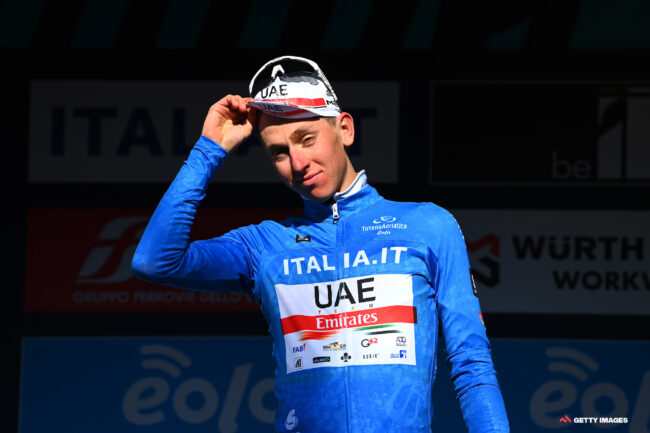||

The question is not whether Pogačar will attack at Milan-San Remo, but where
Many threaten, few try, fewer succeed. Attacking on the Cipressa seems to pull on the climber’s vanity, and Tadej Pogačar is only the latest in a long line to at least vaguely consider a long-range bid for victory at Milan-San Remo.
“I think a long attack at Milan-San Remo, that would be something,” he said, more as a historical contemplation than a threat. But something it would indeed be.
Pogačar’s competitors are worried about his form, which proved unstoppable at Tirreno-Adriatico and Strade Bianche. He’s three-for-three this season, winning the UAE Tour, Strade, and Tirreno, plus a pile of stages within both stage races. Wout van Aert labeled him as his top favorite for San Remo over the weekend. “In Tirreno-Adriatico he could pull away from the rest on any molehill,” he said. There are two key molehills in the finale of Milan-San Remo, and the question is not whether Pogačar will use one to launch, but which one.
The last successful Cipressa attack came from Gabriele Colombo in 1996, but the most famous moves ended in failure. Vincenzo Nibali went for it in 2014, at the peak of his powers. Marco Pantani tried in 1999, flying up the right side of the peloton and into the waiting swarm of TV motorbikes, which pulled him along in symbiotic Italian collaboration. Both crested the climb with a sizable lead but the long, flat coast road to the Poggio was their undoing. Neither stayed away over the Poggio.
They weren’t entirely fruitless endeavors, though. Pantani’s move sent Mario Cipollini out the back, removing the threat of a Saeco train before the race even reached the Poggio. Cipo went on to win the race three years later. Laurent Jalabert, winner in 1995, was sent backwards by Pantani’s move, too.
Therein lies the real value of a Cipressa attack, and the reason for a rider like Pogačar to consider giving it a go.
This is a race with more favorites than almost any other (“I don’t have enough fingers” to count them all, Pogačar said, holding up both hands.). Given the right circumstances, it can suit Classics men, sprinters, climbers, and almost every classy finisher in between. That means the best tactical decisions are often those that serve simply to cull the field. Pogačar needs to tilt those circumstances in his favor. Reducing the number of competitors is in itself a valid reason to push off the front.
The Cipressa is 5.6 km long and averages 4%, with a peak of 9%. It tops out more than 20 kilometers from the finish, but it is a real climb, and attacks there have the benefit of removing those least suited to real climbs – which also happen to be the same riders Pogacar is guaranteed to lose to in a sprint. The modern equivalents of Cipollini and Jalabert are riders like Caleb Ewan and Wout van Aert; if Pogačar wants this Monument, he can’t take them to the line.
Matteo Trentin, Pogačar’s teammate and a vastly more capable sprinter, probably wouldn’t mind if a Cipressa attack got rid of Ewan, either.
Will Pogačar try it? Probably not. If he does, will he succeed? Even less likely. An attack on the Poggio has fewer risks. But Pogačar seems to enjoy defying this sport’s understanding of what’s possible. This weekend, he’ll have another opportunity to do so.
-------------------------------------
By: Caley Fretz
Title: The question is not whether Pogačar will attack at Milan-San Remo, but where
Sourced From: cyclingtips.com/2022/03/the-question-is-not-whether-pogacar-will-attack-at-milan-san-remo-but-where/
Published Date: Mon, 14 Mar 2022 19:42:22 +0000
Did you miss our previous article...
https://playeverysport.com/recreational-sports/best-fishing-coolers-for-2022
.png)





